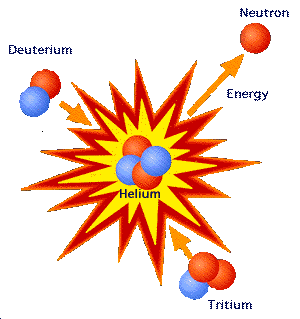Main Page
History
It has been a well-accepted fact that the sun is a source of great power since
the early part of this century. In 1929, scientists first theorized that the
energy production in stars was created by fusion: nuclear reactions involving
light elements reacting to form heavier elements. By the late thirties, H. Bethe
had analyzed most of our sun's nuclear fusion cycle. Fusion in our sun is caused
when deuterium and tritium, both Hydrogen isotopes, react (in the presence of large
amounts of heat) to form Helium, energy, and an extra neutron.

Man-made fusion reactions were thought to be impossible until the first
uncontrolled fusion
reactions were witnessed when nuclear bombs known as "George" and "Mike" were
detonated in 1951 and 1952, respectively. Efforts to control fusion energy
began in the 1950s. By 1955 scientists had witnessed the enormity of the
task. A successful fusion reaction would not only require temperatures in
excess of 50x106 K, but would also need to be isolated for a long enough
time so the reaction could produce more energy than required to begin the
reaction. The most promising fuels for fusion reactions are deuterium, and
tritium. Deuterium and tritium both are hydrogen isotopes. Deuterium is a
stable isotope and is naturally found in water, while tritium is very
unstable, radioactive, and must be man-made. Several methods for containment
exist. They include the Tokamak generator, inertial containment, and mirror
confinement.
Main Page

